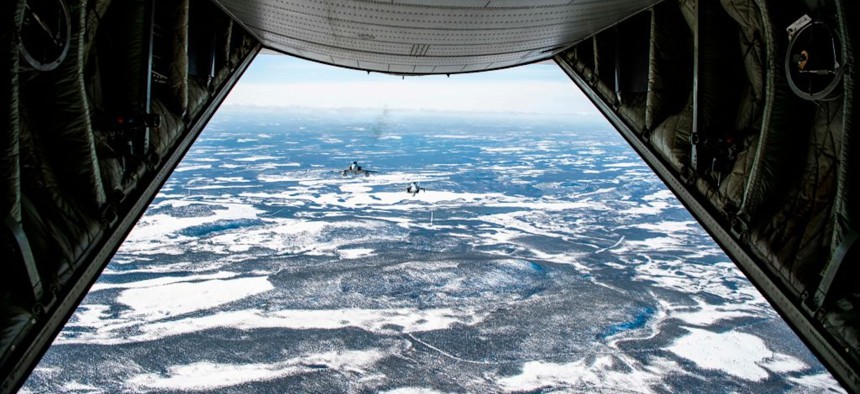
A Swedish Gripen jet (L) and a Finnish F-18 Hornet take part in joint exercises between the two air forces over the Arctic Circle towns of Jokkmokk in Sweden and Rovaniemi in Finland on March 25, 2019. JONATHAN NACKSTRAND / AFP via Getty Images
NATO considering Arctic combined air operations center to deal with Russian threats
“We intercept Russians once or twice per week,” Norway's air chief said.
The recent addition of Sweden and Finland to the NATO alliance is opening up new opportunities for members to better work together in the Arctic, where Russian activity has been increasing. That could mean a new combined air operations center, or CAOC “fairly shortly,” U.S. Air Forces Europe and NATO Allied Air Command Gen. James Hecker said Tuesday at the Air & Space Forces Association's Air Space & Cyber conference.
Hecker said he has U.S. European Command head Gen. Chris Cavoli’s approval to further explore the idea. “We’ve thrown out the idea. Gen. Cavoli in principle agrees with it. That doesn’t mean it’s a done deal,” he told Defense One, noting that the proposal still has to make it through NATO leadership. The location of the potential CAOC is yet to be determined, he said.
During a panel discussion with representatives from the Swedish and Norwegian air forces, Hecker told them: “We're going to exploit that close relationship between the Arctic nations and the knowledge that you bring to make that happen. So we're going to use that, and we're going to exploit it, and I think we'll probably get a third CAOC up there fairly shortly.”
Russian incursions into NATO airspace happen frequently in the Arctic, said Maj. Gen. Øivind Gunnerud, the chief of the Royal Norwegian Air Force. “On average, per year, we intercept Russians once or twice per week [and] their ships all the time.”
Additionally, he said, there is more to consider for air operations there than at lower latitudes. “You will experience icing. Now, inland, dry, cold climate, it has its challenges. But what we see in Norway, we have a lot of the coastal climate, above and below the freezing level all the time. So you have slippery runways. And, of course, it's night [operation] during the winter time. So you better add your night flying skills up there, that's for sure.”
Said Hecker, the U.S. Air Force has been experimenting with MQ-9 Reaper and Global Hawk drones in the Arctic Circle to increase situational awareness, “which we haven't done in the past,” as well as high-altitude balloons and other drones. But, he noted, Arctic conditions offer special challenges to unmanned systems as well, as many are powered via solar panels on the wings.
“That will work out in the summer, probably not so great in the winter,” he said.
If the proposal becomes a reality, the Arctic CAOC would be NATO’s third, joining one in Germany and another in Spain.




